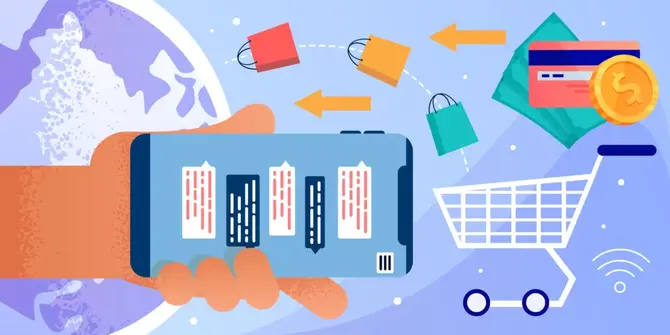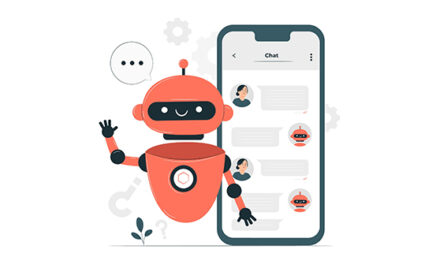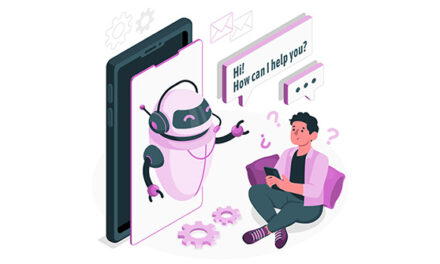“We are already cyborgs,” said Elon Musk in 2016 regarding the integration of technology into our lives. Considering that we have a detailed digital footprint online to go along with our physical lives, this might be partially true. eCommerce is contributing to this not-so-distant reality, and chatbots are a large part of such a vision.
Chatbots are a staple in the eCommerce industry, helping consumers go about shopping, making returns, and troubleshooting logistics issues. The eCommerce industry is in itself an online version of a business, and chatbots would be the helpful androids that would drive the eCommerce industry towards greater efficiencies.
There are several reasons why chatbots are the future of eCommerce, and here are 7 reasons why they are the next big thing in eCommerce:
1. Conversational AI development is driven by data.
Users generate 2.5 quintillion bytes of data daily in 2021, and by 2025 worldwide data stored in the cloud will exceed 200 zettabytes.
Why should these numbers matter?
It’s because conversational AI depends on the availability of high-quality data. Higher volumes of such data mean more advanced and efficient chatbots. If you are wondering if this data is too raw to use for any business operations, you’re right. This is why we use data mining techniques to evaluate large volumes of data to predict trends, detect rare patterns and even find hidden flaws.
Data mining techniques range from statistical processes evaluating massive data sets to association and clustering techniques for categorization. The association method involves applying rules to find patterns in data that aren’t obvious. Clustering technique groups datasets based on similar characteristics.
The eCommerce industry is an infinite well of data generation that rules out any shortage of data volumes or methods to mine and refine said data. This will directly feed conversational AI bots, making them grow in capabilities by leaps and bounds.
2. Integration of Conversational AI with other technologies, such as (Augmented Reality) AR and (Internet of Things) IoT
Conversational AI is at the heart of chatbot technology, using massive datasets, Natural Language Processing, and Machine Learning to converse with humans. Such technologies try to mimic human interaction by studying the input user text. You can use conversational AI collaboratively with other AR, IoT consulting, and VR to provide immersive experiences.
An immersive experience is when you provide a user with a multi-sensory environment and contextually relevant to the customer journey. You can do this by using AR, VR, NLP, AI chatbots, and other related technologies to achieve a near-realistic experience for the user. AI chatbot development company can be your perfect partner in building high-end chatbot.
Immersive experiences have boundless applications. You can use them to train professionals such as engineers and doctors in critical procedures while eliminating risk. This can be in the form of hyperrealistic simulations in aircraft maintenance or medical surgery and a whole lot more. Professionals can gain expertise without risking human life and precious assets.
3. Proactive approach by eCommerce businesses to solve customer needs and issues
The day of reactive customer support is coming to an end. Sure, some novel issues that customers might face will still need reactive support, but proactive customer support is the way forward.
What does this mean?
You, as a business, can reach out to customers before issues occur so that the customer will never face downtime due to your product or service. Using a forecasted customer buyer journey, you can predict what category of issues the customer might face (if any). Chatbots factor into this equation by collecting customer feedback before the issue presents itself. This way, you are a step ahead of the customer and ready to face greater challenges with better efficiency.
Chatbot analytics can provide real-time insights into customer behavior at various stages of the buyer journey. Considering they are the closest thing to an ideal customer support associate, chatbots can initiate dialogue non-intrusively between the customer and company to collect essential data.
You can map user personas based on exit intents, rare queries, and relevant surveys. The number of people who engage with chatbots for this purpose will be relatively higher since they are self-service systems with a human touch.
4. Voice assistants are an integral part of today’s smart device technology
123.5 million US adults will use voice assistants at least once monthly in 2022.
You might already have one at home, in your pocket, or in your car.
Voice assistants are all the rage today, with smart home devices making purchases while cooking and switching off the light when you are about to sleep. Such voice assistants are software that requires only voice input to execute a task. They range from Google assistant to Amazon’s Alexa and are helpful with simple tasks in daily life.
While most users still use keystrokes, taps, and clicks to order items online, there is a steady increase in voice purchases online. The eCommerce companies has always been an innovator when it comes to retail, and most trends that it starts with are spread across other sectors.
With the help of eCommerce chatbots integrated with voice-assistant-enabled smart devices (voice bots), you can provide your customers with a seamless experience. Such seamless customer experiences can be device and platform or channel-agnostic, taking shopping online to the next level.
5. Chatbots will revolutionize automated payments in eCommerce
Automating payments has always been easier said than done over the years. With the advent of advanced conversational bots, businesses have been able to help their customers with bots guiding them through complex payment processes. Such guidance can be consistent and round the clock, building customer trust and loyalty.
Chatbot in oncology practice management software functionality goes way beyond just guiding customers through payment processes. You can program bots to send payment requests to the customer in the chosen currency. Such a flow could be initiated by the user clicking on a button related to a purchase, such as buy now. The user will only have to complete the payment, and the rest of the process will be executed by the chatbot.
Conversational bots also make it easier to comply with the Payment Card Industry (PCI) Data Security Standard (DSS) security standards, introduced in 2006. The tech stacks with which chatbots are built ensure reliable security measures that come with the encryption of financial data.
Tapping into IoT technology, chatbot software enables omnichannel engagement by meeting the customers where they are. With increasing technologies and devices, companies must ensure a seamless experience for customers completing their user journey across devices.
With complex automation such as the scenarios mentioned above, there also comes the advantage of reduced payment processing costs.
6. Chatbots will, at some point, automate large sections of call center processes
We all are familiar with Interactive voice response (IVR) calls that offer self-help and issue classification. In most cases, IVR uses phone strokes and voice inputs to help people access information about something. In case the user does not gain access to the required information, they would then be directed to a human agent for query resolution or troubleshooting.
Chatbots are analogous to IVR in terms of workflow but are omnichannel-compatible and exponentially faster. What does this mean for call centers? Chatbots can take on the role of IVR in call centers to automate calls to a greater extent than thought possible. While IVR is restricted to phone calls, chatbots transcend media and channels and can be implemented efficiently and with great consistency.
A user can be met with a warm AI-generated voice to resolve their query or issue for simple to medium issues and queries. Any complex issues can be directed to an appropriately and adequately skilled human agent for resolution.
Call scheduling, virtual queuing, and forecasting automation are the main areas where call centers can benefit from AI chatbots. With this automation, you can contact the customer when it’s time to re-purchase a product or renew a contract. You can also manage calls by assigning them ticket numbers and informing agents of disconnected calls to be called back. Using forecasting, you can choose the best times to provide product recommendations or send reminders for sales. Chatbots can help turn call centers into profit centers with the right implementation.
7. Chatbot analytics provide customer insights in real-time
All companies should focus on the customer experience to ensure the consumer keeps coming back for more. While human interaction is being minimized with more online businesses, this is not necessarily a bad thing. You can use self-service powered by real-time chatbot analytics to help customers solve issues independently.
It presents us with two distinct advantages – customers can seek help and always find it with chatbots, which is non-intrusive. Another advantage is called the Ikea effect, where the user feels a sense of accomplishment when they solve issues with minimal help.
State-of-the-art business intelligence tools and integrations power chatbot analytics. You can see the entire buyer journey on your eCommerce store in real-time without waiting for delayed data. Chatbots are a significant driver in this initiative since they collect data at various touchpoints online using exit intent popups, feedback forms, reviews, and so on.
The Final Word
Chatbots are driving innovation in the eCommerce industry and technology as a whole with AI, VR, and associated technologies. Immersive experiences might become the new norm in online shopping and payments will become seamless going forward. An omnichannel presence will be the minimum bar for online businesses, and smart devices and smarter chatbot automation will help us get there.




